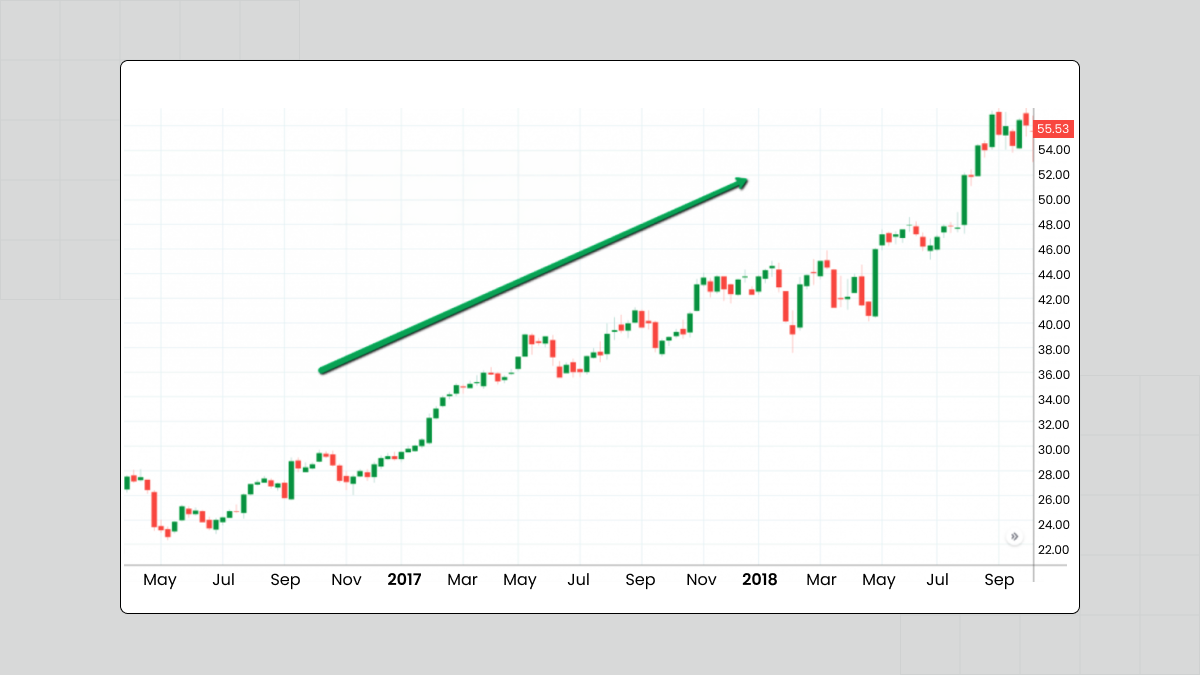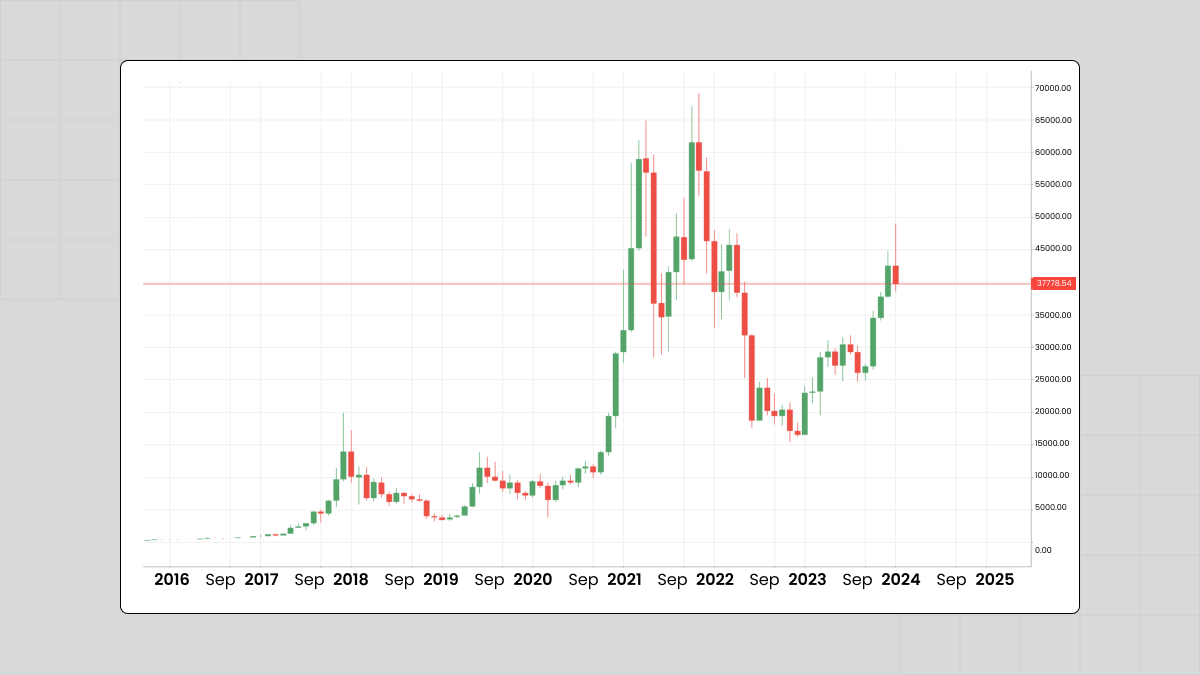What Is A Bull Market?

If you need more understanding of the meaning of a bull market, this article will give you a detailed overview of this market phenomenon. The following sections will unravel what is a bull market in stocks and other trading assets, giving you everything you need to know about it to feel more confident as a trader.
What’s a bull market?
The following section will get you familiar with the meaning of a bull market, give you examples of what is a bull market in stocks, Forex pairs, etc., answer the questions most beginner traders ask: “how long does a bull market last?”, and “is it “good” or “bad”?".
So, what is a bull market?
The definition of a bull market comes from the image of a bull attacking its prey by thrusting its horns upward. A bull market refers to a period of generally rising prices and investor confidence. Market actors used the term to describe a positive, optimistic market environment where stocks are expected to grow in value.
Bull market example
2017-2018 chart for APPL
Look at the two-year APPL chart: the steady inclination you see is the bullish trend.

Another example is Bitcoin, arguably the world’s top cryptocurrency known for its dramatic behavior changes. Here, we see that BTCUSD showing significant bullish trends abrupt with sudden downfalls – bearish trends, the opposite of the bull market.
The latter happens constantly in trading, but we will come back to this in a few sections.
Key characteristics of a bull market
As you know from the definition of a bull market, mostly investors see it as a positive trend. We can point out the following characteristics to describe it:
- Rising asset prices.
- Investor confidence.
- Economic growth.
- Low unemployment.
- High trading volume.
- Positive sentiment.
- Increased mergers and acquisitions.
- Low interest rates.
A bull market occurs against the backdrop of a positive political and economic environment. It is a period of growth and confidence fueled by good news. But bullish trends can't last forever, as the market is no stranger to dramatic turnarounds. However, as history shows, the market tends to heal itself, resulting in new growth and chart slopes with new highs higher than the previous ones and new lows never falling back to the earlier levels.
How long does a bull market last?
The duration of bull and bear markets over the past 100 years
A bull market can last up to several months. However, no matter how long a bullish trend gets, it always ends with a bearish one. But don’t fret; there’s a way to look at this cycle positively.
If we zoom out on the market, we will get a broader scope of it and see that the whole bullish/bearish trends inheritance is part of a larger bullish trend.
One of the best ways to look at the market is to consider it a fractal, where smaller-scale events are exact copies of larger-scale events. And the larger trend, the prevailing trend, is a bull market. So, within this ever-growing bullish market, you can stumble upon smaller periods of bullish trends followed by bearish ones, and then the cycle repeats itself.
What’s a bull market in terms of good and bad?
If you should look at a bull market through the lens of the good-or-bad dichotomy, it’s safe to say that it’s is generally considered favorable for investors and the economy. During a bull market, asset prices rise, leading to higher investment returns and increased investor wealth.
While a bull market often reflects a strong and growing economy and high levels of investor confidence, it's worth noting that it may come with some risk, and investors need to remain cautious and aware of potential market downturns.
How to invest in a bull market
By now, the question "What is a bull market?" should no longer be on your mind. What you're probably wondering is what your trading modus operandi should be during this trend.
Investing in a bull market requires a thoughtful and strategic approach to capitalize on the upward momentum while managing potential risks. Here are some key considerations for investing in a bull market:
- Maintain a long-term perspective. Despite favorable market conditions, resist the temptation to chase short-term gains. Instead, focus on building a well-diversified portfolio with a mix of stocks, bonds, and other asset classes that match your investment goals and risk tolerance.
- Conduct thorough research. Look for companies with strong fundamentals, solid earnings growth, and a competitive advantage within their industry. Avoid market hype and speculation and focus instead on investing in companies with sustainable growth prospects.
- Practice risk management. Diversifying your portfolio can mitigate the impact of market downturns and reduce overall volatility. In addition, consider using stop-loss orders to protect against sudden price declines and avoid excessive use of leverage or margin trading.
- Maintain a disciplined approach to investing. Avoid making emotional decisions based on short-term market fluctuations and stick to your long-term investment strategy.
- Follow market trends, economic indicators, and geopolitical events. Being aware of potential risks and staying on top of market developments can help you make informed investment decisions in a bull market.
Risks to be aware of in a bull market
When speaking of bull market risk, the best place to start is the potential for overvaluation of assets. During a bull market, investor optimism can lead to inflated prices that the underlying fundamentals of the companies may not support. This can lead to a market correction or even a crash when the overvalued assets are eventually reassessed based on their actual value.
Another risk of a bull market is complacency. As prices rise, investors may become complacent and overlook potential warning signs or risks in the market. This can lead to a lack of diversification in investment portfolios and a failure to assess and manage risk adequately.
Excessive leverage and margin trading are common in bull markets as investors become more confident in the upward trajectory of stock prices. While leverage can magnify returns in a rising market, it can also magnify losses in a downturn, potentially leading to significant financial distress for overleveraged investors.
Geopolitical events, economic downturns, and unexpected market shocks can occur even during a bull market, leading to sudden and severe market declines. Investors must remain vigilant and prepared for such events, even in a robust market environment.
A bull market can be a lucrative time for investors; however, it’s crucial to remain cautious and aware of the potential risks. Diversification, risk management, and staying informed are essential strategies for managing the risks of a bull market.
Wrap-up
A bull market can be a fantastic opportunity to turn this positive trend into a trader’s favor. To make that happen, a trader should focus on high-quality, fundamentally sound investments with solid growth potential. Allocating a higher percentage of one’s portfolio to stocks and sectors that typically perform well in bull markets – technology, consumer discretionary, and financials – is also a good idea.
Traders should also review their portfolios regularly to take advantage of new opportunities. Diversifying a portfolio and avoiding excessive risk-taking can help prevent dramatic losses.
Finally, staying updated about market trends and economic indicators will help a trader make informed investment decisions during a bull market.
FAQ
How do you invest in a bull market?
Investing in a bull market can be stripped down to a few go-to tips, including:
- Stick to a quality portfolio.
- Follow your financial plan.
- Continue to build your gains.
- Take a gradual approach to investing and selling.
- Be on the side of market momentum.
- Use options to hedge your risk.
Is it good to buy in the bull market?
Traditionally, a bull market is considered a favorable time to invest. However, one must take note of risks that may occur, as bullish markets tend to give way to bearish trends, resulting in financial losses.
Should I invest in a bull or bear market?
Investing in a bull market can be advantageous as rising stock prices and positive investor sentiment typically characterize it. However, investing in a bear market can also present opportunities, as stock prices are generally lower and may offer attractive entry points for long-term investors.
Consider your risk tolerance, investment goals, and time horizon when deciding whether to invest in a bull or bear market. Diversifying your portfolio, seeking professional advice, and staying informed about market trends can help you make informed decisions regardless of market conditions. Ultimately, the decision to invest in a bull or bear market should be based on carefully considering your financial situation and investment objectives.
What is the best investment in a bull market?
Usually, bulls, bull market investors, focus on growth-oriented assets such as stocks, particularly those of companies with solid fundamentals and potential for future earnings growth. Other sectors that do well in a bull market include technology, consumer discretion, and health care. Some bulls consider investing in exchange-traded funds (ETFs) that track broad market indexes or specific sectors.




